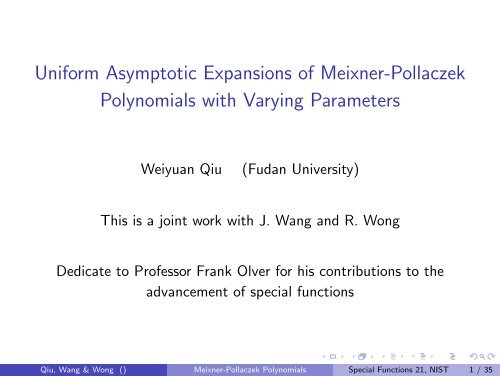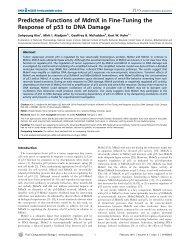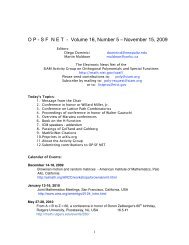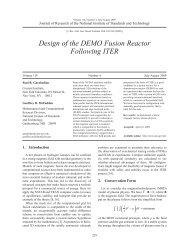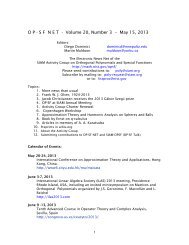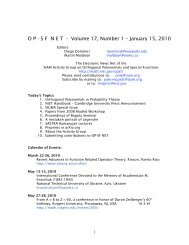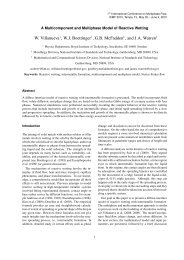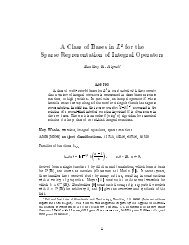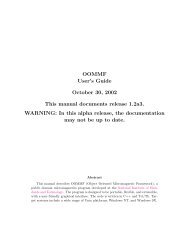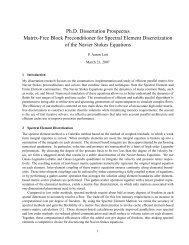Weiyuan Qiu
Weiyuan Qiu
Weiyuan Qiu
You also want an ePaper? Increase the reach of your titles
YUMPU automatically turns print PDFs into web optimized ePapers that Google loves.
Uniform Asymptotic Expansions of Meixner-Pollaczek<br />
Polynomials with Varying Parameters<br />
<strong>Weiyuan</strong> <strong>Qiu</strong> (Fudan University)<br />
This is a joint work with J. Wang and R. Wong<br />
Dedicate to Professor Frank Olver for his contributions to the<br />
advancement of special functions<br />
<strong>Qiu</strong>, Wang & Wong () Meixner-Pollaczek Polynomials Special Functions 21, NIST 1 / 35
Introduction<br />
In this talk, we concern with the uniform asymptotics of the<br />
Meixner-Pollaczek (MP) polynomials as the degree n tends to infinity.<br />
The Meixner-Pollaczek polynomials were first discovered by Meixner<br />
(1934) and later studied by Pollaczek (1950). The major properties<br />
were discussed by Chihara (1978), Koekoek and Swarttouw (1998).<br />
Certainly, we can find the MP polynomials in DLMF.<br />
<strong>Qiu</strong>, Wang & Wong () Meixner-Pollaczek Polynomials Special Functions 21, NIST 2 / 35
Introduction<br />
The Meixner-Pollaczek polynomials P (λ)<br />
n (x; φ) with parameters λ > 0<br />
and φ ∈ (0, π) can be defined by the hypergeometric functions<br />
P (λ)<br />
n (x; φ) = (2λ)n<br />
n! einφ 2F1<br />
−n, λ + ix<br />
2λ<br />
; 1 − e −2iφ<br />
.<br />
They are orthogonal on the real line with respect to the weight<br />
function<br />
w(x; λ, φ) = |Γ(λ + ix)| 2 exp{(π − 2φ)x},<br />
and we have the orthogonality<br />
+∞<br />
−∞<br />
P (λ)<br />
m (x; φ)P (λ)<br />
n (x; φ)w(x; λ, φ)dx =<br />
Γ(n + 2λ)<br />
(2 sin φ) 2λ n! δmn.<br />
<strong>Qiu</strong>, Wang & Wong () Meixner-Pollaczek Polynomials Special Functions 21, NIST 3 / 35
Introduction<br />
The asymptotic analysis of the MP polynomials P (λ)<br />
n (x; φ) as n → ∞.<br />
Y.Chen and M.Ismail (1997) investigated the asymptotic behaviors of<br />
the extreme zeros of the MP polynomials, and also the asymptotic<br />
distribution of zeros in symmetric case.<br />
X.Li and R.Wong (2001) obtained an asymptotic expansion of the<br />
MP polynomials in terms of the parabolic cylinder functions which is<br />
valid uniformly in the interval [−nM, nM] for a given M > 0. They<br />
also obtained the improved asymptotic behaviors of the zeros.<br />
I.V.Krasovsky (2003) also investigated the asymptotic distribution of<br />
zeros of MP polynomials on the approach of the semiclassical WKB<br />
analysis of difference equations.<br />
<strong>Qiu</strong>, Wang & Wong () Meixner-Pollaczek Polynomials Special Functions 21, NIST 4 / 35
Introduction<br />
The aim of our work is to derive asymptotic expansions of the MP<br />
polynomials P (λ)<br />
n (z; φ) in the complex plane with varying large<br />
parameter λ, say λ = λn ∼ nA for some constant A > 0.<br />
The uniform asymptotics of orthogonal polynomials with varying<br />
weights was investigated by many authors, e.g. P.Deift and his<br />
collaborators for varying exponential weights. Many of these works<br />
focused on the weights with a varying large parameters, in particular,<br />
on the Laguerre polynomials Lαn .<br />
n and Jacobi polynomials P (αn,βn)<br />
n<br />
<strong>Qiu</strong>, Wang & Wong () Meixner-Pollaczek Polynomials Special Functions 21, NIST 5 / 35
Introduction<br />
Here are some references.<br />
C.Bosbach and W.Gawronski (1998), A.B.J.Kuijlaars and<br />
K.McLaughlin (2001), A.Aptekarev and R.Khabibullin (2007) et.al.<br />
for the Laguerre polynomials;<br />
C.Bosback and W.Gawronski (1999), A.B.J.Kuijlaars and<br />
A.Martinez-Finkelshtein (2004), A.Martinez-Finkelshtein and R.Orive<br />
(2005), R.Wong and W.J.Zhang (2006) et.al. for the Jacobi<br />
polynomials.<br />
V.S.Buyarov, J.S.Dehesa, A.Martinez-Finkelshtein and E.B.Saff<br />
(1999) discussed the asymptotics of information entropy both for<br />
Jacobi and Laguerre polynomials.<br />
<strong>Qiu</strong>, Wang & Wong () Meixner-Pollaczek Polynomials Special Functions 21, NIST 6 / 35
Introduction<br />
Our uniform asymptotic expansions are for P (τA)<br />
n<br />
τ = n + 1<br />
2<br />
. The result is given as follows.<br />
(τz, φ) with<br />
In a bounded region (a “rectangle” containing the support of the<br />
equilibrium measure), the expansion involves the parabolic cylinder<br />
functions;<br />
In an unbounded region (outside of the “rectangle”), the expansion<br />
involves the elementary functions. These two regions are overlapped<br />
and the union of them covers the whole plane.<br />
Our method is the Riemann-Hilbert approach developed by P.Deift<br />
and X.Zhou. This powerful method has been already successfully<br />
applied in the asymptotic analysis for many orthogonal polynomials.<br />
<strong>Qiu</strong>, Wang & Wong () Meixner-Pollaczek Polynomials Special Functions 21, NIST 7 / 35
Fundamental Riemann-Hilbert problem<br />
Let πn(z) be the monic polynomials of the MP polynomials. Let<br />
Y : C \ R → C2×2 be the 2 × 2 matrix-valued function<br />
<br />
<br />
Y (z) =<br />
πn(z)<br />
cnπn−1(z)<br />
C[πnw](z)<br />
cnC[πn−1w](z)<br />
,<br />
where cn = −2πi(2 sin φ) 2(n+λ−1) /[(n − 1)!Γ(n + 2λ − 1)], and<br />
C[f](z) := 1<br />
+∞ f(x)<br />
dx, z ∈ C \ R,<br />
2πi −∞ x − z<br />
is the Cauchy transform of f.<br />
<strong>Qiu</strong>, Wang & Wong () Meixner-Pollaczek Polynomials Special Functions 21, NIST 8 / 35
Fundamental Riemann-Hilbert problem<br />
From the well-known result of Fokas, Its and Kitaev, Y (z) satisfies<br />
the following Riemann-Hilbert problem (RHP):<br />
(Ya) Y (z) is analytic in C \ R;<br />
(Yb) for x ∈ R,<br />
<br />
<br />
Y+(x) = Y−(x)<br />
1<br />
0<br />
w(x; λ, φ)<br />
1<br />
;<br />
(Yc) for z ∈ C \ R and z → ∞,<br />
<br />
1<br />
<br />
Y (z) = I + O<br />
z<br />
<br />
zn 0<br />
0 z−n <br />
.<br />
<strong>Qiu</strong>, Wang & Wong () Meixner-Pollaczek Polynomials Special Functions 21, NIST 9 / 35
Fundamental Riemann-Hilbert problem<br />
Now we set λ = λn = τA where τ = n + 1<br />
2<br />
rescale transform<br />
U(z) =<br />
<br />
τ −n 0<br />
0 τ n<br />
<br />
Y (τz).<br />
and A > 0, and make a<br />
Then U(z) satisfies a RHP similar to Y (z) but with the jump matrix<br />
<br />
1<br />
0<br />
wn(x)<br />
1<br />
,<br />
where wn(x) is the weight function with varying parameter λ = τA,<br />
that is,<br />
wn(x) = w(τx; τA, φ).<br />
<strong>Qiu</strong>, Wang & Wong () Meixner-Pollaczek Polynomials Special Functions 21, NIST 10 / 35
Fundamental Riemann-Hilbert problem<br />
The weight function wn(x) has an analytic continuation<br />
wn(z) = Γ(τA + iτz)Γ(τA − iτz) exp{(π − 2φ)τz}<br />
which has singularities at z = ±(k/τ + A)i, (k = 0, 1, 2, . . .).<br />
The difficult in our arguments is that wn(z) is quite complicate which<br />
involves the Gamma functions.<br />
<strong>Qiu</strong>, Wang & Wong () Meixner-Pollaczek Polynomials Special Functions 21, NIST 11 / 35
Equilibrium measures<br />
The equilibrium measure µn(x)dx related to the weight function<br />
wn(x) is supported on the interval [αn, βn], where the constants αn,<br />
βn are known as the Mhaskar-Rakhmanov-Saff numbers (MRS<br />
numbers).<br />
Let<br />
G(z) := 1<br />
βn µn(s)<br />
πi αn s − z ds, z ∈ C \ [αn, βn]<br />
be the Cauchy transform of µn(x).<br />
Then<br />
G+(x) + G−(x) = − i d<br />
πτ dx log wn(x), x ∈ (αn, βn).<br />
<strong>Qiu</strong>, Wang & Wong () Meixner-Pollaczek Polynomials Special Functions 21, NIST 12 / 35
Equilibrium measures<br />
Let<br />
h(z) = − d<br />
dz log wn(z) = i[ψ(τA − iτz) − ψ(τA + iτz)] − (π − 2φ),<br />
where ψ(z) = d log Γ(z)/dx = Γ ′ (z)/Γ(z).<br />
From the Plemelj formula, we get that<br />
<br />
(z − αn)(z − βn)<br />
G(z) =<br />
2πτ 2 βn h(s) 1<br />
<br />
i<br />
(s − αn)(s − βn) s − z ds.<br />
Then, the equilibrium measure µn(x) is given by<br />
αn<br />
µn(x) = Re G+(x), x ∈ [αn, βn].<br />
<strong>Qiu</strong>, Wang & Wong () Meixner-Pollaczek Polynomials Special Functions 21, NIST 13 / 35
Equilibrium measures<br />
The MRS numbers αn, βn can be determined by<br />
βn<br />
αn<br />
βn<br />
αn<br />
i[ψ(τA − iτs) − ψ(τA + iτs)] − (π − 2φ)<br />
ds = 0,<br />
(s − αn)(s − βn)<br />
i[ψ(τA − iτS) − ψ(τA + iτs)] − (π − 2φ)<br />
sds = 2τπ.<br />
(s − αn)(s − βn)<br />
The asymptotic expansions of αn, βn as n → ∞ can be obtained by<br />
the use of the asymptotic formula of ψ(z)<br />
ψ(z) ∼ log z − 1<br />
2z −<br />
∞<br />
k=1<br />
B2k<br />
2k z−2k ,<br />
for |z| → ∞ in | arg z| < π, where Bn are the Bernoulli numbers.<br />
<strong>Qiu</strong>, Wang & Wong () Meixner-Pollaczek Polynomials Special Functions 21, NIST 14 / 35
Equilibrium measures<br />
The result expansions of αn, βn are given by<br />
αn ∼<br />
∞<br />
j=0<br />
where the first coefficients are<br />
aj<br />
n j , βn ∼<br />
∞<br />
j=0<br />
bj<br />
,<br />
nj a0 = (A + 1) cot φ − √ 2A + 1<br />
,<br />
sin φ<br />
b0 = (A + 1) cot φ + √ 2A + 1<br />
,<br />
sin φ<br />
and aj, bj can be determined iteratively.<br />
<strong>Qiu</strong>, Wang & Wong () Meixner-Pollaczek Polynomials Special Functions 21, NIST 15 / 35
Equilibrium measures<br />
Let σ(z) = (z − αn)(z − βn), z ∈ C \ [αn, βn], σ(z) ∼ z, z → ∞,<br />
C(x) := (x − αn) β 2 n + A 2 − (x − βn) α 2 n + A 2 , and<br />
D(x) := 2 (βn − x)(x − αn) Im (−iA − βn)(iA − αn)].<br />
From µn(x) = Re G+(x), we can get for x ∈ [αn, βn],<br />
µn(x) = 1 C(x) + D(x)<br />
log<br />
2π C(x) − D(x) +<br />
<br />
(x − αn)(βn − x)<br />
Fn(x),<br />
4πτ<br />
where<br />
Fn(x) ∼<br />
1<br />
(x + iA)σ(−iA) +<br />
1<br />
(x − iA)σ(iA) +<br />
ωk(x) =<br />
1<br />
<br />
(2k − 1)!<br />
i<br />
(s − x)σ(s)<br />
∞<br />
k=1<br />
(2k−1) −iA<br />
iA .<br />
(−1) kB2k ωk(x),<br />
kτ 2k−1<br />
<strong>Qiu</strong>, Wang & Wong () Meixner-Pollaczek Polynomials Special Functions 21, NIST 16 / 35
Equilibrium measures<br />
For the symmetric case αn = −βn (i.e. φ = π/2), the asymptotic<br />
behavior of µn(x) reduces to<br />
µn(x) ∼ 1<br />
2π log<br />
<br />
βn 2 + A2 + βn 2 − x2 <br />
βn 2 + A2 − βn 2 ,<br />
− x2 which is very similar to that already obtained by Y. Chen and<br />
M. Ismail in 1997.<br />
<strong>Qiu</strong>, Wang & Wong () Meixner-Pollaczek Polynomials Special Functions 21, NIST 17 / 35
The mapping φn(z)<br />
As pointed by P.Deift et.al., it is important to introduce an auxiliary<br />
functions φn(z) related to the weight function wn(z) or µn.<br />
Let νn(z) = πiG(z) + 1<br />
2 h(z),<br />
z ∈ C \ ([αn, βn] ∪ {z = ±(A + k/τ)i : k = 0, 1, 2, . . . }).<br />
Then νn,±(x) = ±πiµn(x) for x ∈ (αn, βn).<br />
νn(z) has asymptotics<br />
νn(z) ∼ i C(z) + D(z) σ(z)<br />
log +<br />
2 C(z) − D(z) 4τ Fn(z)<br />
uniform valid in a domain bounded away from cuts [αn, βn],<br />
[iA, +i∞) and (−i∞, −iA], where<br />
D(z) = −2i Im (−iA − βn)(iA − αn)σ(z).<br />
<strong>Qiu</strong>, Wang & Wong () Meixner-Pollaczek Polynomials Special Functions 21, NIST 18 / 35
The mapping φn(z)<br />
The auxiliary function φn(z) is defined by<br />
φn(z) =<br />
z<br />
βn<br />
νn(s)ds,<br />
which is analytic on C \ ((−∞, βn] ∪ [iA, i∞) ∪ (−i∞, −iA]).<br />
Symmetrically, the function ˜ φn(z) is<br />
˜φn(z) =<br />
z<br />
αn<br />
νn(s)ds,<br />
z ∈ C \ ([αn, ∞) ∪ [iA, i∞) ∪ (−i∞, −iA]).<br />
<strong>Qiu</strong>, Wang & Wong () Meixner-Pollaczek Polynomials Special Functions 21, NIST 19 / 35
The mapping φn(z)<br />
Given 0 < c < 1 and M > max {|αn|, |βn|}, define the rectangle<br />
K = K(c, M) = {z ∈ C : | Re z| < M, | Im z| < cA}, and K± the<br />
upper and lower half of K.<br />
The mapping properties of φn(z) on the real axis:<br />
◮ If x ∈ [βn, ∞), then φn(x) ∈ [0, ∞), and when x moves from ∞<br />
to βn, φn(x) moves from ∞ to 0 decreasingly.<br />
◮ If x ∈ [αn, βn], then φn,+(x) ∈ [−iπ, 0], and when x moves from<br />
βn to αn, φn,+(x) moves from 0 to −iπ monotonically.<br />
◮ If x ∈ (−∞, αn], then φn,+(x) ∈ [−iπ, ∞ − iπ), and when x<br />
moves from αn to −∞, φn,+(x) moves from −iπ to ∞ − iπ<br />
increasingly.<br />
<strong>Qiu</strong>, Wang & Wong () Meixner-Pollaczek Polynomials Special Functions 21, NIST 20 / 35
The mapping φn(z)<br />
There is 0 < c < 1, for any M > max{|αn|, |βn|}, φn(z) is a<br />
one-to-one mapping from the upper-half rectangle K+ = K+(c, M)<br />
to a region in C \ {z : Re z ≥ 0, −π ≤ Im z ≤ 0}.<br />
K+<br />
iA<br />
cA<br />
−M αn 0 βn M<br />
φn<br />
Symmetrically on the lower half rectangle K−.<br />
0<br />
−πi<br />
<strong>Qiu</strong>, Wang & Wong () Meixner-Pollaczek Polynomials Special Functions 21, NIST 21 / 35
Asymptotics of U(z) outside of K<br />
Now we can follow from the standard arguments of the<br />
Riemann-Hilbert approach by a series transformations.<br />
U → T : the normalization of U(z) at infinity by using the logarithm<br />
potential of equilibrium measure,<br />
T → S: the matrix decomposition and the contour deformation,<br />
S has an approximation S∞ which satisfies a solvable RHP.<br />
Solving this limit RHP, we can get the asymptotic behavior of U(z)<br />
outside of a neighborhood of [αn, βn] (e.g. outside of the rectangle K).<br />
<strong>Qiu</strong>, Wang & Wong () Meixner-Pollaczek Polynomials Special Functions 21, NIST 22 / 35
Asymptotics of U(z) outside of K<br />
The result asymptotic behavior of U(z) outside of K is given by<br />
where<br />
U(z) ∼ e 1<br />
2 τℓnσ3<br />
1<br />
Vout(z)wn(z) ˜ − 2 σ3 , z ∈ C \ (K ∪ R),<br />
˜Vout(z) = 1<br />
2<br />
<br />
<br />
1 0<br />
bn(z)<br />
−2i<br />
−σ3<br />
<br />
1 i<br />
e<br />
−1 i<br />
−τφn(z)σ3 ,<br />
−i(2z−αn−βn)<br />
βn−αn<br />
◮ bn(z) = [(z − αn)(z − βn)] 1/4 / √ βn − αn for z ∈ C \ (−∞, βn],<br />
1<br />
0<br />
◮ the constants ℓn ∼ 2A log τ<br />
◮ and σ3 is Pauli’s matrix<br />
0<br />
−1<br />
<strong>Qiu</strong>, Wang & Wong () Meixner-Pollaczek Polynomials Special Functions 21, NIST 23 / 35<br />
<br />
.
Asymptotics of U(z) inside in K<br />
To obtain the asymptotic behavior of U(z) inside in K, we need to<br />
construct a parametrix V (z) = ˜ Vin(z) such that<br />
<br />
it satisfies the jump condition V+(x) = V−(x)<br />
1<br />
0<br />
1<br />
1<br />
for x ∈ R,<br />
and it has asymptotic behavior like ˜ Vout on the boundary of K<br />
(matching condition).<br />
The mapping properties of φn(z) invokes us to construct our<br />
approximate solution by using the parabolic cylinder function.<br />
<strong>Qiu</strong>, Wang & Wong () Meixner-Pollaczek Polynomials Special Functions 21, NIST 24 / 35
Asymptotics of U(z) inside in K<br />
From F. Olver’s significant work on the asymptotics of the parabolic<br />
cylinder functions U(−τ, 2 √ τξ) as τ → ∞, we introduce the function<br />
f(ξ) = ξ ξ 2 − 1 − log(ξ + ξ 2 − 1), ξ ∈ C \ (−∞, 1].<br />
This is a one-to-one mapping from upper half plane C + to the region<br />
C \ {z : Re z ≥ 0, −π ≤ Im z ≤ 0}.<br />
−1 0 1<br />
f 0<br />
−πi<br />
<strong>Qiu</strong>, Wang & Wong () Meixner-Pollaczek Polynomials Special Functions 21, NIST 25 / 35
Asymptotics of U(z) inside in K<br />
Combining f(ξ) with the mapping properties of the auxiliary function<br />
φn(z), we establish a one-to-one mapping between ξ ↔ z defined by<br />
for z ∈ K.<br />
f(ξ(z)) = φn(z), or equiv. ξ(z) = f −1 ◦ φn(z),<br />
This mapping maps the rectangle K to a neighborhood of [−1, 1],<br />
and ξ(αn) = −1, ξ(βn) = 1.<br />
<strong>Qiu</strong>, Wang & Wong () Meixner-Pollaczek Polynomials Special Functions 21, NIST 26 / 35
Asymptotics of U(z) inside in K<br />
To construct the parametrix satisfying the jump condition, we use the<br />
connection formula for the parabolic cylinder functions<br />
√ 2πU(a, ±x)<br />
= Γ( 1<br />
2<br />
1 1<br />
a+<br />
− a){e−iπ( 2 4 ) U(−a, ±ix) + e<br />
This yields the matrix equation (jump relation)<br />
√ n!<br />
U(−τ, 2 τξ) √<br />
2πin U(τ, −2i√τξ) √1 U<br />
τ ′ (−τ, 2 n!<br />
(τ)ξ) √<br />
2πτin+1 U ′ (τ, −2i √ <br />
=<br />
τξ)<br />
√ n!i U(−τ, 2 τξ) − n<br />
√ U(τ, 2i<br />
2π √ τξ)<br />
1<br />
√ τ U ′ (−τ, 2 (τ)ξ) − n!in+1<br />
√ 2πτ U ′ (τ, 2i √ τξ)<br />
1 1<br />
iπ( a+ 2 4 ) U(−a, ∓ix)}.<br />
1 <br />
1<br />
.<br />
0 1<br />
<strong>Qiu</strong>, Wang & Wong () Meixner-Pollaczek Polynomials Special Functions 21, NIST 27 / 35
Asymptotics of U(z) inside in K<br />
To match the behavior of ˜ Vout on ∂K, we use Olver’s uniform<br />
asymptotic approximation of the parabolic cylinder functions:<br />
U(−τ, 2 √ τξ) ∼ 1<br />
√ τ<br />
2 τ<br />
2<br />
U(τ, −2i √ τξ) ∼ in+1<br />
√ 2 τ<br />
1 τ<br />
− − 4 e 2<br />
τ 1<br />
− − 2 4 e τ<br />
2<br />
1<br />
[ξ 2 (z) − 1] 1/4 e−τφn(z) ,<br />
uniformly for ξ ∈ C \ (−∞, 1] (z ∈ C \ (−∞, βn]).<br />
1<br />
[ξ 2 (z) − 1] 1/4 eτφn(z) ,<br />
U ′ (−τ, 2 √ τξ) and U ′ (τ, −2i √ τξ) have the corresponding<br />
approximations.<br />
<strong>Qiu</strong>, Wang & Wong () Meixner-Pollaczek Polynomials Special Functions 21, NIST 28 / 35
Asymptotics of U(z) inside in K<br />
Insert above asymptotic approximations into the matrix equation for<br />
jump relation, and comparing it with ˜ Vout(z), we construct the<br />
parametrix for z ∈ K+<br />
˜Vin(z) = 1<br />
√ 2 τ<br />
·<br />
τ 1<br />
− + 2 4 e τ<br />
2<br />
<br />
1 0<br />
−i(2z−αn−βn)<br />
βn−αn<br />
−2i<br />
(ξ 2 − 1) 1/4<br />
bn(z)<br />
U(−τ, 2 √ τξ) n!<br />
√ 2πi n U(τ, −2i√ τξ)<br />
1<br />
√ τ U ′ (−τ, 2 (τ)ξ)<br />
n!<br />
√ 2πτi n+1 U ′ (τ, −2i √ τξ)<br />
Similar construction of the parametrix can be given for z ∈ K−.<br />
<strong>Qiu</strong>, Wang & Wong () Meixner-Pollaczek Polynomials Special Functions 21, NIST 29 / 35<br />
<br />
σ3<br />
.
Asymptotic expansions of U(z)<br />
Define<br />
⎧<br />
⎨e<br />
Ũ(z) =<br />
⎩<br />
1<br />
2 τℓnσ3<br />
1<br />
Vin(z)wn(z) ˜ − 2 σ3 , z ∈ K \ R,<br />
e 1<br />
2 τℓnσ3<br />
1<br />
Vout(z)wn(z) ˜ − 2 σ3 , z ∈ C \ (K ∪ R).<br />
We have formally that U(z) ∼ Ũ(z).<br />
To give a rigorous prove, and to obtain the asymptotic expansion, we<br />
define the matrix<br />
1<br />
−<br />
S(z) = e 2 τℓnσ3 U(z)Ũ −1 (z)e 1<br />
2 τℓnσ3 .<br />
<strong>Qiu</strong>, Wang & Wong () Meixner-Pollaczek Polynomials Special Functions 21, NIST 30 / 35
Asymptotic expansions of U(z)<br />
It is easy to verify that S(z) is the solution of the following RHP:<br />
(Sa) S(z) is analytic in C \ Σ, where Σ = Σ0 ∪ Σ1 ∪ Σ2, Σ0 = ∂K,<br />
Σ1 = (−∞, −M] and Σ2 = [M, ∞);<br />
(Sb) S+(ζ) = S−(ζ)JS(ζ) for ζ ∈ Σ;<br />
(Sc) S(z) ∼ I + O(1/z) as z ∈ C \ Σ and z → ∞.<br />
Σ0<br />
Σ1 K<br />
Σ2<br />
−M M<br />
<strong>Qiu</strong>, Wang & Wong () Meixner-Pollaczek Polynomials Special Functions 21, NIST 31 / 35
Asymptotic expansions of U(z)<br />
Applying the uniform asymptotic expansions of the parabolic cylinder<br />
functions U(−τ, 2 √ τξ), U(τ, −2i √ τξ), etc., the jump matrix JS(ζ)<br />
has an asymptotic expansion on the contour Σ:<br />
JS(ζ) ∼ I +<br />
∞ J (m)<br />
m=1<br />
S (ζ)<br />
, ζ ∈ Σ0,<br />
(2τ) m<br />
JS(x) ∼ I + O(e −cn1/4<br />
), x ∈ Σ1 ∪ Σ2.<br />
The coefficients J (m)<br />
S (ζ) can be determined by the coefficients of<br />
expansions of the parabolic cylinder functions.<br />
<strong>Qiu</strong>, Wang & Wong () Meixner-Pollaczek Polynomials Special Functions 21, NIST 32 / 35
Asymptotic expansions of U(z)<br />
From the expansion of JS on Σ, we can prove that the solution S(z)<br />
of RHP (Sa) − (Sc) also has a uniform asymptotic expansion:<br />
S(z) ∼ I +<br />
∞<br />
m=1<br />
S (m) (z)<br />
,<br />
(2τ) m<br />
where the coefficients S (m) (z) can be determined recursively.<br />
Then we obtain<br />
U(z) ∼ e 1<br />
2 τℓnσ3<br />
<br />
I +<br />
∞<br />
m=1<br />
S (m) (z)<br />
(2τ) m<br />
<br />
1<br />
−<br />
e 2 τℓnσ3 Ũ(z).<br />
Take the (1,1)-entry, we get the uniform asymptotic expansion of<br />
πn(τz).<br />
<strong>Qiu</strong>, Wang & Wong () Meixner-Pollaczek Polynomials Special Functions 21, NIST 33 / 35
Asymptotic expansions of πn(τz)<br />
In the rectangle K, we have the uniform asymptotic expansion<br />
πn(τz) = 1<br />
√ e<br />
2 τ<br />
2 (ℓn+1) τ n<br />
1<br />
− 2 wn(z) 2 [ U(−τ, 2 √ τξ(z)) A(z, n)<br />
+ U ′ (−τ, 2 √ τ ξ(z)) B(z, n) ]<br />
where A(z, n) and B(z, n) are analytic functions of z, and<br />
A(z, n) ∼ (ξ2 − 1) 1 <br />
4<br />
1 +<br />
bn(z)<br />
B(z, n) ∼ bn(z)<br />
(ξ2 − 1) 1<br />
4<br />
∞<br />
k=1<br />
∞ Bk(z)<br />
.<br />
k=1<br />
1<br />
k+ τ 2<br />
Ak(z)<br />
τ k<br />
<br />
,<br />
<strong>Qiu</strong>, Wang & Wong () Meixner-Pollaczek Polynomials Special Functions 21, NIST 34 / 35
Asymptotic expansions of πn(τz)<br />
Outside of K, we have the uniform asymptotic expansion<br />
πn(τz) ∼ 1<br />
2 τ n e τ<br />
2 ℓn bn(z) −1 1<br />
−<br />
wn(z) 2 e −τφn(z)<br />
<br />
1 +<br />
∞<br />
k=1<br />
Ck(z)<br />
τ k<br />
<br />
<strong>Qiu</strong>, Wang & Wong () Meixner-Pollaczek Polynomials Special Functions 21, NIST 35 / 35
Asymptotic expansions of πn(τz)<br />
Outside of K, we have the uniform asymptotic expansion<br />
πn(τz) ∼ 1<br />
2 τ n e τ<br />
2 ℓn bn(z) −1 1<br />
−<br />
wn(z) 2 e −τφn(z)<br />
<br />
1 +<br />
Thank you for your attention.<br />
∞<br />
k=1<br />
Ck(z)<br />
τ k<br />
<br />
<strong>Qiu</strong>, Wang & Wong () Meixner-Pollaczek Polynomials Special Functions 21, NIST 35 / 35


